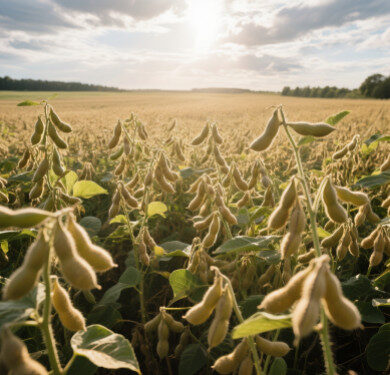China’s soybean industry focuses on meeting domestic demand through a mix of domestic production and strategic imports, while advancing agricultural modernization
Core Findings
-
Sustained Growth in Production
-
2024 Metrics:
-
Cultivation Area: 15.487 million hectares (ha)
-
Total Output: 20.652 million tons
-
Yield: 1,333.5 kg/ha
-
-
11-Year Trend (2013-2024):
-
Area ↑46.46% | Output ↑66.46% | Yield ↑13.66%
-
-
Dominance: Soybeans constitute 87.3% of China’s total legume cultivation area and output.
-
-
Regional Concentration
-
Northeast China (Heilongjiang, Inner Mongolia, Jilin):
-
51.0% of cultivation area | 49.4% of output
-
-
Western China:
-
26.5% of area | 25.8% of output
-
-
70%+ of national production occurs in Northeast and Western regions.
-
-
Provincial Leadership
-
Top 10 Provinces (Heilongjiang, Inner Mongolia, Sichuan, Anhui, Henan, Jilin, Shandong, Jiangsu, Hubei, Hunan):
-
Contribute >84.5% of national output.
-
-
Heilongjiang Dominance:
-
43%+ of national output | 46.7% of cultivation area (2023).
-
-
Production Analysis
1. Cultivation Area Stability
-
2024 Area: 15.487 million ha (↓1.4% YoY but 46.5%↑ vs. 2013).
-
Policy Driver: “Expand Soybean-Oilseed Production” initiative since 2022.
-
*Figure 1: China’s Soybean Cultivation Area Trend (2013-2024)*
2. Output Resilience
-
2024 Output: 20.652 million tons (↓0.9% YoY but 66.5%↑ vs. 2013).
-
Subsidies and tax incentives bolster farmer engagement.
-
*Figure 2: China’s Soybean Output Trend (2013-2024)*
3. Yield Improvement
-
2024 Yield: 1,333.5 kg/ha (13.7%↑ vs. 2013; CAGR: 1.17%).
-
Technology adoption offsets land constraints.
-
*Figure 3: Soybean Yield Per Unit Area Trend (2013-2024)*
Regional Layout
1. Macro-Regional Distribution (2023)
| Region | Cultivation Area Share | Output Share |
|---|---|---|
| Northeast | 50.96% | 49.44% |
| West | 26.50% | 25.82% |
| Central | 15.51% | 15.39% |
| East | 7.03% | 9.36% |
-
Figure 4: Regional Distribution of Soybean Area & Output
2. Provincial Output Concentration
-
CR10 (Top 10 Provinces): >84.5% of national output.
-
CR2 (Heilongjiang + Inner Mongolia): >54% of output.
-
Heilongjiang: 44.5% of output | 46.7% of area (2023).
-
*Figure 5: Provincial Output Concentration Trends (2019-2023)*
3. Productivity Disparities
-
Jiangsu: #10 in area but #2 in yield → #8 in output.
-
Guizhou: #8 in area but #29 in yield → #15 in output.
-
Figure 6: Provincial Rankings by Area, Yield & Output (2023)
Figures Summary
| Figure | Title | Key Insight |
|---|---|---|
| 1 | Soybean vs. Other Legumes (2023-2024) | Soybeans dominate legume production (87%+ share), with stable YoY structure. |
| 2 | Cultivation Area Trend (2013-2024) | Area stabilized >15M ha after policy interventions (2022). |
| 3 | Output Trend (2013-2024) | Output consistently >20M tons since 2022 despite minor fluctuations. |
| 4 | Yield Per Unit Trend (2013-2024) | Technological gains drive yield growth (CAGR 1.17%). |
| 5 | Regional Output Distribution (2023) | Northeast + West = 75%+ of national output. |
| 6 | Top 20 Provinces: Output Ranking Shift | Heilongjiang, Inner Mongolia, Anhui consistently lead; regional gaps persist. |
| 7 | Provincial Output Concentration | CR10 stability confirms high geographic consolidation. |
| 8 | Provincial Rankings (Area/Yield/Output) | Yield efficiency determines output rank despite area disparities (e.g., Jiangsu). |
| 9 | Provincial Share of National Output | Heilongjiang’s dominance (44.5%) anchors national production. |
Strategic Implications
-
Import Dependency: 83.6% (2024) due to low yields vs. staple grains (e.g., rice: 7,155 kg/ha).
-
Policy Priority: “14th Five-Year Plan” targets yield innovation and Western region expansion.
-
Emerging Regions: Northwest (Xinjiang, Gansu) and Southwest (Yunnan, Guizhou) testing new models.
Data Source: National Bureau of Statistics (NBS); Analysis by Nong Xiaofeng (abeedata.com).
*Note: 1 hectare = 15 mu; Yield converted to kg/ha (original data in kg/mu).*









